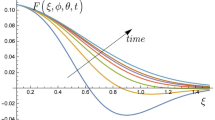Abstract
The quantum Fokker–Planck equation (QFPE) is revisited. Provided that the molecule is the Maxwellian molecule, the quantum Landau–Fokker–Planck equation is divided into characteristic four terms. The characteristics of three terms among four terms are investigated on the basis of Grad’s method, whereas the characteristics of the remained term, which is attributed to the collisional term of the QFPE proposed by Kaniadakis–Quarati, when the distribution function of the colliding partner is under the equilibrium state, are numerically investigated. The numerical result indicates that the time evolution of the distribution function obtained using such a remained term is instable, when the equilibrium or nonequilibrium state is given as initial data of the distribution function. Such an instability of the distribution function can be described by analyzing the propagation of the plane harmonic wave in one dimensional velocity space.




Similar content being viewed by others
Notes
\(H_{ijk\ldots }^{(n)}\) is equivalent to \(H_{v_iv_jv_k\ldots }^{(n)}\).
References
Dalfovo, F., Giorgini, S., Pitaevskii, L.P., Stringari, S.: Theory of Bose–Einstein condensation in trapped gases. Rev. Mod. Phys. 71, 463–512 (1999)
Jackson, B., Adams, C.S.: Damping and revivals of collective oscillations in a finite-temperature model of trapped Bose–Einstein condensation. Phys. Rev. A 63, 053606 (2011)
Cerboneschi, E., Menchini, C., Arimondo, E.: Monte Carlo simulations of Bose–Einstein condensation of trapped atoms. Phys. Rev. A 62, 013606 (2000)
Wade, A.C.J., Baillie, D., Blakie, P.B.: Direct simulation Monte Carlo method for cold atom dynamics: classical Boltzmann equation in the quantum collision regime. Phys. Rev. A 84, 023612 (2011)
Bird, G.A.: Molecular Gas Dynamics and Direct Simulation of Gas Flows. Oxford Science, Oxford (1994)
Uehling, E.A., Uhlenbeck, G.E.: Transport phenomena in Einstein–Bose and Fermi–Dirac gases. Phys. Rev. 43, 552–561 (1933)
Grad, H.: On the kinetic theory of rarefied gases. Comm. Pure Appl. Math. 2, 331 (1949)
Nouri, A.: An existence result for a quantum BGK model. Math. Comput. Model. 47(3–4), 515–529 (2008)
Chapman, S., Cowling, T.G.: The Mathematical Theory of Non-uniform Gases, 3rd edn. Cambridge University Press, Cambridge (1970)
Yano, R.: Semi-classical expansion of the distribution function using modified Hermite polynomials for quantum gas. Physica A. 416, 231–241 (2014)
Kaniadakis, G., Quarati, P.: Kinetic equation for classical particles obeying an exclusion principle. Phys. Rev. E 48, 4263–4270 (1993)
Carrillo, J.A., Rosado, J., Salvarani, F.: 1D nonlinear Fokker–Planck equations for Fermions and Bosons. Appl. Math. Lett. 21, 148–154 (2008)
Carrillo, J.A., Laurencot, P., Rosado, J.: Fermi–Dirac–Fokker–Planck equation: well posedness and long-time asymptotics. J. Differ. Equ. 247, 2209–2234 (2009)
Toscani, G.: Finite time blow up in Kaniadakis–Quarati model of Bose–Einstein particles. Commun. Partial. Differ. Equ. 37(1), 77–87 (2012)
Villani, C.: On the spatially homogeneous Landau equation for Maxwellian molecules. Math. Methods Model Appl. Sci. 8(6), 957–983 (1998)
Desvillettes, L., Villani, C.: On the spatially homogeneous Landau equation for hard potentials part I: existence uniqueness and smoothness. Comm. Partial Differ. Equ. 25(1–2), 179–259 (2000)
Desvillettes, L., Villani, C.: On the spatially homogeneous Landau equation for hard potentials part II: H-theorem and applications. Comm. Partila Differ. Equ. 25(1–2), 261–298 (2000)
Yano, R., Suzuki, K., Kuroda, H.: Analytical and numerical study on the nonequilibrium relaxation by the simplified Fokker–Planck equation. Phys. Fluids 21, 047104 (2009)
Müller, I., Ruggeri, T.: Rational Extended Thermodynamics. Springer Tracts in Natural Philosophy, 2nd edn. Springer, New York (1998)
Ikenberry, E., Truesdell, C.: On the pressures and the flux of energy in a gas according to Maxwell’s kinetic theory I. J. Ration. Mech. Anal. 5(1), 55 (1956)
Author information
Authors and Affiliations
Corresponding author
Appendix: Derivation of Terms \(\fancyscript{M}_1\), \(\fancyscript{M}_2\), \(\fancyscript{M}_3\) and \(\fancyscript{M}_4\)
Appendix: Derivation of Terms \(\fancyscript{M}_1\), \(\fancyscript{M}_2\), \(\fancyscript{M}_3\) and \(\fancyscript{M}_4\)
In this appendix, we derive four terms \(\fancyscript{M}_1\), \(\fancyscript{M}_2\), \(\fancyscript{M}_3\) and \(\fancyscript{M}_4\) from the quantum Landau–Fokker–Planck equation, when the molecule is the Maxwellian molecule. The \(ij\)-element of \(3 \times 3\) matrix \(A(g)\), namely, \(\left[ A\left( g\right) \right] _{ij}\), is rewritten using the peculiar velocity, when the molecule is the Maxwellian molecule, as
where \(C_{1,i}=v_{1,i}-u_i\) is the peculiar velocity of the colliding partner.
Substituting \(\left[ A\left( g\right) \right] _{ij}\) in Eq. (24) into the gain term of the quantum Landau–Fokker–Planck equation for the Maxwellian molecule in Eq. (1) (\(G_{\text{ QFPE }}\)), we obtain
where \(\fancyscript{A}\), \(\fancyscript{B}_{ij}\), \(\fancyscript{B}\) and \(\Gamma _i\) are defined by Eqs. (3–6), respectively.
Substituting \(\left[ A\left( g\right) \right] _{ij}\) in Eq. (24) into the loss term of the quantum Landau–Fokker–Planck equation for the Maxwellian molecule in Eq. (1) (\(L_{\text{ QFPE }}\)), we obtain
Rights and permissions
About this article
Cite this article
Yano, R. On Quantum Fokker–Planck Equation. J Stat Phys 158, 231–247 (2015). https://doi.org/10.1007/s10955-014-1123-7
Received:
Accepted:
Published:
Issue Date:
DOI: https://doi.org/10.1007/s10955-014-1123-7




